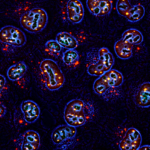Lien vers Pubmed [PMID] – 17283066
Mol. Cell. Biol. 2007 Apr;27(7):2661-75
Tumor suppressor HIC1 (hypermethylated in cancer 1) is a gene that is essential for mammalian development, epigenetically silenced in many human tumors, and involved in a complex pathway regulating P53 tumor suppression activity. HIC1 encodes a sequence-specific transcriptional repressor containing five Krüppel-like C(2)H(2) zinc fingers and an N-terminal BTB/POZ repression domain. Here, we show that endogenous HIC1 is SUMOylated in vivo on a phylogenetically conserved lysine, K314, located in the central region which is a second repression domain. K314R mutation does not influence HIC1 subnuclear localization but significantly reduces its transcriptional repression potential, as does the mutation of the other conserved residue in the psiKXE consensus, E316A, or the overexpression of the deSUMOylase SSP3/SENP2. Furthermore, HIC1 is acetylated in vitro by P300/CBP. Strikingly, the K314R mutant is less acetylated than wild-type HIC1, suggesting that this lysine is a target for both SUMOylation and acetylation. We further show that HIC1 transcriptional repression activity is positively controlled by two types of deacetylases, SIRT1 and HDAC4, which increase the deacetylation and SUMOylation, respectively, of K314. Knockdown of endogenous SIRT1 by the transfection of short interfering RNA causes a significant loss of HIC1 SUMOylation. Thus, this dual-deacetylase complex induces either a phosphorylation-dependent acetylation-SUMOylation switch through a psiKXEXXSP motif, as previously shown for MEF2, or a phosphorylation-independent switch through a psiKXEP motif, as shown here for HIC1, since P317A mutation severely impairs HIC1 acetylation. Finally, our results demonstrate that HIC1 is a target of the class III deacetylase SIRT1 and identify a new posttranslational modification step in the P53-HIC1-SIRT1 regulatory loop.

